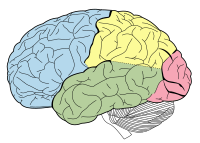
Photo from wikipedia
Background Scholars have long understood that gastrointestinal microorganisms are intimately related to human disorders. The literature on research involving the gut microbiome and neuroscience is emerging. This study exposed the… Click to show full abstract
Background Scholars have long understood that gastrointestinal microorganisms are intimately related to human disorders. The literature on research involving the gut microbiome and neuroscience is emerging. This study exposed the connections between gut microbiota and neuroscience methodically and intuitively using bibliometrics and visualization. This study’s objectives were to summarize the knowledge structure and identify emerging trends and potential hotspots in this field. Materials and methods On October 18, 2022, a literature search was conducted utilizing the Web of Science Core Collection (WoSCC) database for studies on gut microbiota and neuroscience studies from 2002 to 2022 (August 20, 2022). VOSviewer and CiteSpace V software was used to conduct the bibliometrics and visualization analysis. Results From 2002 to 2022 (August 20, 2022), 2,275 publications in the WoSCC database satisfied the criteria. The annual volume of publications has rapidly emerged in recent years (2016–2022). The most productive nation (n = 732, 32.18%) and the hub of inter-country cooperation (links: 38) were the United States. University College Cork had the most research papers published in this area, followed by McMaster University and Harvard Medical School. Cryan JF, Dinan TG, and Clarke G were key researchers with considerable academic influence. The journals with the most publications are “Neurogastroenterology and Motility” and “Brain Behavior and Immunity.” The most cited article and co-cited reference was Cryan JF’s 2012 article on the impact of gut microbiota on the brain and behavior. The current research hotspot includes gastrointestinal microbiome, inflammation, gut-brain axis, Parkinson’s disease (PD), and Alzheimer’s disease (AD). The research focus would be on the “gastrointestinal microbiome, inflammation: a link between obesity, insulin resistance, and cognition” and “the role of two important theories of the gut-brain axis and microbial-gut-brain axis in diseases.” Burst detection analysis showed that schizophrenia, pathology, and psychiatric disorder may continue to be the research frontiers. Conclusion Research on “gastrointestinal microbiome, inflammation: a link between obesity, insulin resistance, and cognition” and “the role of two important theories of the gut-brain axis and microbial-gut-brain axis in diseases” will continue to be the hotspot. Schizophrenia and psychiatric disorder will be the key research diseases in the field of gut microbiota and neuroscience, and pathology is the key research content, which is worthy of scholars’ attention.
Journal Title: Frontiers in Neuroscience
Year Published: 2022
Link to full text (if available)
Share on Social Media: Sign Up to like & get
recommendations!